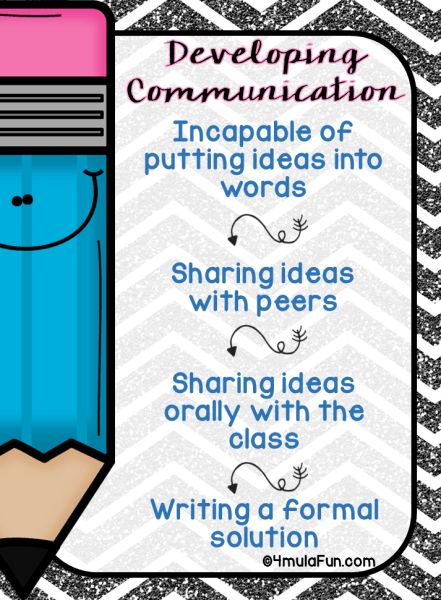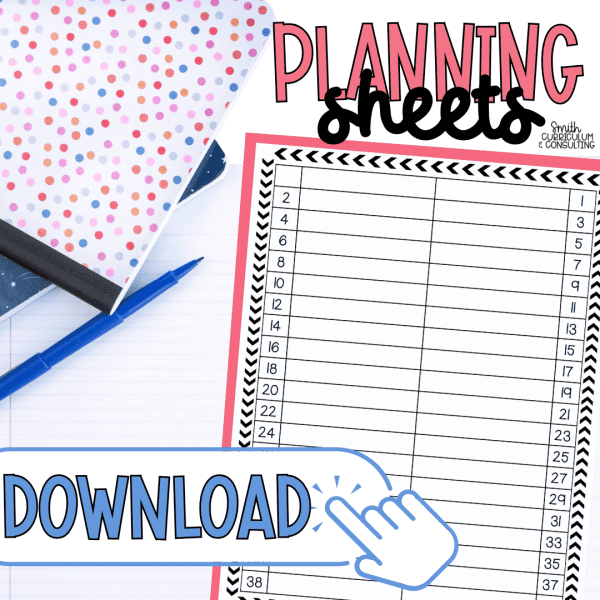
Within the Common Core State Standards (CCSS) and Texas Essential Knowledge and Skills (TEKS) new standards have arisen to promote the communication of math skills. Common Core Math Practice Standard 3 states, “Students should construct viable arguments and critique the reasoning of others,” while the Texas Essential Knowledge and Skills Math Practice Standard 1d states, “The student is expected to communicate mathematical ideas, reasoning, and their implications using multiple representations, including symbols, diagrams, graphs, and language as appropriate,” and Standard 1f states, “The student is expected to analyze mathematical relationships to connect and communicate mathematical ideas.”
Why is there so much focus on communicating mathematical ideas when focusin g on problem solving? Communication increases students’ self reliance and belief that they themselves can find answers on their own. We as teachers see it every day where a student will just want you to spoon feed them the information they are supposed to know so they can get to the next step. This is not teaching them to problem solve, this is teaching them to rely on others and not think for themselves. We have to change this mindset in the classroom.
Communciation is more than just talking about individual problems but is also about connecting topics from day to day. In my classroom I did great with allowing my students to talk about what they were currently learning and creating relationships with their peers on what they were learning. What I struggled with is making my students think to what they had already learned and make connections. So when I am teaching about ratios and proportions, have students connect their learning to what they know about percentages and fractions. How do they relate together? How are they similar? How does your knowlege of fractions help you develop your understanding of proportions and being able to solve them correctly? See how easy it is and can spark creative thinking with your students?
Learning to ask questions is a communication habit. Don’t get upset with the kid who CONSTANTLY asks questions, they are learning! I know it is hard when Trevor (totally made up student) is asking questions every 5 minutes and you just want to get through your lesson. Accommodate his need for asking questions by giving him some post it notes and allowing him to write them down when he has a question and stick them on his desk. You may end up sparking some really good conversations in your classroom with these  questions. You may want to even create a Parking Lot for questions in your classroom and allow any of your students to do the same with questions they may have about what is being taught. This will limit the interruptions in your lesson especially when the questions may not completely align with the topic at hand. Build in time in your weekly lessons for classroom discussion/debate about some of these questions to help students develop their communication skills with each other.
questions. You may want to even create a Parking Lot for questions in your classroom and allow any of your students to do the same with questions they may have about what is being taught. This will limit the interruptions in your lesson especially when the questions may not completely align with the topic at hand. Build in time in your weekly lessons for classroom discussion/debate about some of these questions to help students develop their communication skills with each other.
“I know it but I don’t know how I know it.” How many times have you had this answer given in class? Many students struggle with the notion of being able to talk about their thinking and although they may know an answer but aren’t sure how they got there. This shows an inability to put math ideas into words on their own. Buidling in the time for classroom discussions/debates will allow students to start inputting ideas over time as they are comfortable. Challenge your students to contribue one mathematical idea daily in class whether it be on classroom brain dump done via Post It Note or outloud in class.

Ever student enters our classroom at a different stage on the communication scale (shown above). As teachers we are often overzealous in wanting to hear every student’s ideas that we don’t tend to think about what stage of mathematical communcation each of them may be coming to us at. We can’t expect a beginning problem solver to explain in detail their thinking and what they are doing. We have to allow them to communicate at their ability level and then foster that level to continue and travel down the path to the next level of communication. Our students all come into our classroom with a wide variety of skills, abilities and preferences when it comes to communicating and we must seek out new ideas to recognize that thinking and promote their growth.
Communication should ALWAYS have a purpose. As a learner we always prefer authentic tasks and communcation tasks that are motivated behind the lesson at hand. NO ONE wants to do busy work! Communcation comes in many forms from discussing problems within a group, writing out their solutions, oral explanations, etc. If a student struggles with one area of communication find what they excel in and focus on that! Just like the Post-It Note Parking Lot example earlier being great for written expression, allow students to communicate through technology. Submit questions via email, a Facebook group or Twitter. Heck, what about taking a picture and posting it on Instagram and tagging the classroom Instagram page. Students can them collaborate together and discuss the thinking that comes behind the problem.
In our classrooms we must create a culture of communication. Creating a classroom culture is more than just setting guidelines, it is also building up students to know how to talk about mathematical ides, know what it means to be respectful of others ideas and having tasks that require them to write for real communication. These three steps are easy to facilitate but also very crucial. Setting guidelines as a class not only allows students to take ownership but also helps to develop the family aspect. Once these guidelines are set, don’t just post them and be done but take time to model them regularly.
Later this week I plan to come back and discuss more about communication and give direct ideas on fostering communciation in your math classroom today beyond those given already. If you have any questions or ideas feel free to submit them in the comments so that we can all develop our mathematical communication together!

Don’t forget to check out Week 1’s post on Why Practical Problem Solving is Important. Next week will be all about Analyzing Relationships which you won’t want to miss!
Teach Me About Math Workshop!
Looking for all the latest about using Math Workshop in the Middle Grades? Join today and grab the FREE Editable Math Workshop Sheets and all of the great emails to come your way!
Success! Now check your email to confirm your subscription.




